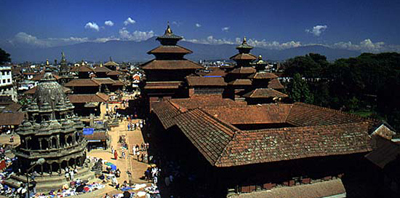


Historical City Tour with Jungle Safari

- Itinerary
- Cost Info
- Departure
HIstorical City Tour with Jungle Safari
Day 01 : Kathmandu - Arrival and transfer to the hotel. Afternoon sightseeing of Patan and Tibetan Centre.
Patan: Also known as “Lalitpur” literally the city of fine arts is perhaps a living museum as she still retains her medieval air of the ancient times and almost half the inner city residents are craftsmen in their own right. Patan was one of the major Buddhist cities in Asia by the 7th century as pilgrims, scholars and monks from India, Tibet and China visited the city. It is said that at one stage the entire population of Patan City was comprised of monks and craftsmen only. The city is full of Hindu temples, Buddhist monuments and structures with bronze gateways, guardian deities and wonderful metal and woodcarvings. In ancient times the ancestors of present day craftsmen were invited to Tibet and as far as Peking to built monasteries, pagodas and images of Buddha and other revered.
Day 02 : Kathmandu - Morning sightseeing of Bhaktapur and Thimi. Afternoon sightseeing of Kathmandu and Swayambhu.
Bhaktapur: Also known as Bhadgaon, it is situated at an altitude of 1401 m, is a home to medieval art and architecture and was the site for Burtoluchhi’s Little Buddha. The urban city covers an area of 4 sq. miles. Shaped like a conch-shell, Bhaktapur meaning city of Devotees, pottery and weaving are its traditional industries. Bhaktapur, essence of the Newari City, 14 km east of Kathmandu is Nepal’s greatest treasures.
Bhaktapur Durbar Square is a conglomeration of pagoda and shikhara-style temples grouped around a fifty-five window palace of brick and wood. The square is one of the most charming architectural showpieces of the Valley as it highlights the ancient arts of Nepal. The golden effigies of kings perched on the top of stone monoliths, the guardian deities looking out from their sanctuaries, the wood carvings in every place-struts, lintels, uprights, tympanums, gateways and windows-all seem to form a well-orchestrated symphony.
Thimi: Thimi is a farming town situated 8 km east of Kathmandu on the way to Bhaktapur. Exquisite temples and other religious shrines dot its streets. It is known for its artistic masks and earthen pots, often seen spread out on the streets to dry in the sun. It can be called a traditional pottery locality with almost 80% of the population still involved in pottery. Handspun cotton cloth is another Thimi specialty.
Kathmandu Durbar Square: Durbar square classic tour takes you to the famous places that have housed kings of different dynasties and temple-scapes representing the finest expamples of Hindu and Buddhist architectures.
Some of the important monuments to be seen here are:
Taleju temple- tallest of all structures built by king Mahendra Malla in 1549 A.D.
Jagannath temple- built in the 16th century, known for fascinating erotic figures carving I the wooden struts eaves.
Kal Bhairav- one of the largest stone idol in Kathmandu representing the terrifying aspects of Shiva.
Statue of King Pratap Malla in praying gesture to Digu Taleju the royal family deity right across.
Kumari Ghar- 17th century Kumari temple, an example of the highly developed Nepalese temple craft.
Kasthamandap- built from the timber of a single tree. The Kathmandu City derives its name from Kasthamandap.
Besides this other fascinating part of this palace complex is the towering Nautale Durbar overlooking the beautiful cityscape and the vast Basantapur square where Prithivi Narayan Shah built mansion to commemorate his victory in 1768 A.D. This building complex is known for the most intricately carved wooden doorways roof struts and massive lattice windows full of mythical figures.
Swayambhunath: One of the world’s most glorious, ancient, enigmatic and the holiest of Buddhist Chaityas, dating back more than 2000 years. Situated on a hillock Swayambhunath, literally “the Self-Created or Existent”, is a mosaic of small stupas and pagoda temple contributed over time by the succession of kings and noblemen. The main structure of the stupa is made of a solid hemisphere of brick and clay, supporting a lofty conical spire and capped by pinnacle of copper gilt. Painted on the four sides on the base of the spire are the “All Seeing Eyes” of Lord Buddha. The main features of Swayambhunath in brief are “The Five Buddhas.”
Day 03 : Kathmandu/Chitwan - Departure from Kathmandu and drive to Chitwan. Afternoon jungle activities. Overnight stay at Safari Island jungle resort Lodge.
Drive to Chitwan National Park. We will be welcomed with warm hospitality. Naturalists at the ghat (river crossing point) will transfer you by canoes across the River to the waiting elephants which will ferry you to your camp, situated in the heart of the Park the home to the great one horned rhinoceros, sloth bear, wild boar, gaur(bison), 4 species of deer, 2 species of monkeys, 2 species of crocodiles, leopard, the elusive Royal Bengal Tiger, over 400 species of birds and various other reptiles. Briefing takes place as you arrive and lodges are assigned. Some activities takes place to penetrate deep into the jungle for viewing and photographing wildlife, experience the abundant bird-life, the flora and fauna. Overnight full board at Temple Tiger Resort.
Day 04 : Chitwan - Full day jungle activities which include elephant and canoe ride.
Early morning you will be mounted on elephant back and then taken for a jungle safari for 2 -3 hours penetrating through dense 18-20 ft grasslands. It is the favourite habitat of the rhinoceros and other mammals. After breakfast you will be taken to the elephant stables where talk about the habits of the elephants takes place. Here you may witness the rare scene of the elephants at bath. Take your bathing suit along. In the afternoon you may just relax around the camp or take a dugout canoe ride down the Narayani River to view the gharial and the marsh mugger crocodiles. Dinner will be served around the campfire at the Resort.
Day 05 : Chitwan/Kathmandu - Drive back to Kathmandu after breakfast. Day at leisure.
Day 06 : Kathmandu - Morning sightseeing of Pashupati and Boudha. Rest of the day at leisure.
Pashupatinath: Just a small walk takes you to the temple of Lord Shiva-Pasupatinath with a two tiered golden roof and silver doors. This structure is famous for its superb Newari architecture, situated near the banks of the sacred Bagmati River. Entrance to the temple precinct is permitted to the “Hindus Only”, however visitors can clearly see the temple from the eastern bank of the Bagmati River. Pashupati, literally, “Lord of the Animals” is the patron deity of Nepal and believed to have been unearthed by an obscure herdsman while one of his cattle was showering the earth with milk. Across the sacred river, above the array of decorated monuments, is the “Slasmantak or Mrigasthali Ban (forest)” where legends has it that Lord Siva dwelled in a form of an antelope to evade the hordes of demigods.
Bouddhanth: This colossal and ancient Stupa, one of Nepal’s most unique monuments and said to be the world's biggest, attracts Nepalese pilgrimage of Tibetan stock from as far as Dolpo and Mugu as well as Tibet, Ladhak in India and Bhutan. Baudhanath Stupa, with all seeing eyes of primordial Adi Buddha on all the four sides of the stupa, is said to hold the remains of Kasyapa - the Buddha of the previous time.The Stupa is 100 meters in diameter and was built on an octagonal base. Inset into the base are prayer wheels established by the Lichchivi King Mana Deva in the fifth century. The stupa rises to 36 meters above the base including the spire, “all seeing eyes” and the pinnacle represents the stages of enlightenment, symbol of royalty, compassion, knowing and nirvana. There are many myths about the origins of the stupa. We'll have lunch here after the sightseeing (around 1330hrs).
Day 07 : Kathmandu - Transfer to airport for return flight.
Trip Cost :